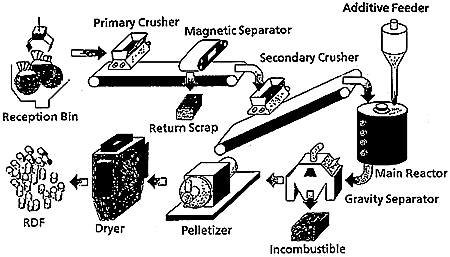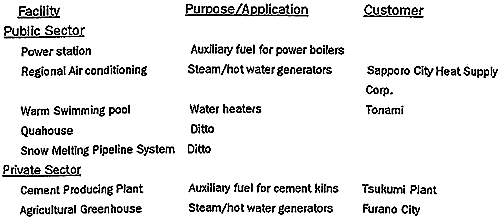Waste Treatment Technology in JAPAN
Crushing, Sorting
(1) The use of an additive .
- dehydration by hygroscopic exothermic reaction;
1. Introduction
Large cities and towns the world over are literally being choked to death by the refuse they generate. The trouble is erection of refuse-treating facilities, be it a municipal waste incinerator or a garbage burial site, is becoming the more difficult because of enmity of the concerned regional residents, not to mention the rising costs of construction and maintenance and the environment problems, the bills of all of which have to be passed over to the citizens at large.
One way to relieve them of this trouble is surely to turn the refuse into a usable or recirculating resource, and the J-Catrel Process we are introducing here to you is definitely one of the most effective-can even be profitable-method for the purpose.
2. The J-Catrel Process
The J-Catrel Process, so called in honor of the Swiss firm that has developed it into an industrial reality, is a system that liberates the energy the refuse still holds in the form of a refuse derived fuel (RDF). The RDF it produces stands long term storage and needs no special equipment, such as municipal waste incinerator, to burn it as will be discussed shortly.
Basically, the J-Catrel Process is of a crush-and-compaction method as illustrated below.

3. Features of the J-Catrel Process
The J-Catrel Process is decorated with many features as may be surmised in
the illustration above. Some of them are emphasized as follows:
Owing to its reaction with the organic matter in the garbage, following effects develop:
(2) Automatic Sorting:
- prevention of blazing on to the dryer walls;
- quick pelletization with the additive working as a binder;
- reduced gas emission when burnt as RDF;
- prevention of putrefaction of the garbage; and
- formation of biologically stable and sanitarily harmless solid fuel.
The input refuse is automatically cleaned of metals and other incombustible for recovery while it travels through the plant.
(3) Compact Dryer:
The plant arrangement of doing the pelletization before drying has allowed the use of a compact dryer, while reducing the inherent humidity of the product RDF substantially.
(4) Stable RDF Quality:
As the feed undergoes repeated mixing and temporary storage many times over, the composition is equalized remarkably. This results in the production of RDF with highly stabilized quality.
4. Use of the J-Catrel RDF
The RDF thus made can be, and actually has been, used as a handy fuel that is capable of standing long-term storage for various sorts of heating equipment. As may be imagined from following examples, the J-Catrel RDF has no preference as to the type of size of the furnace it is burned in.
